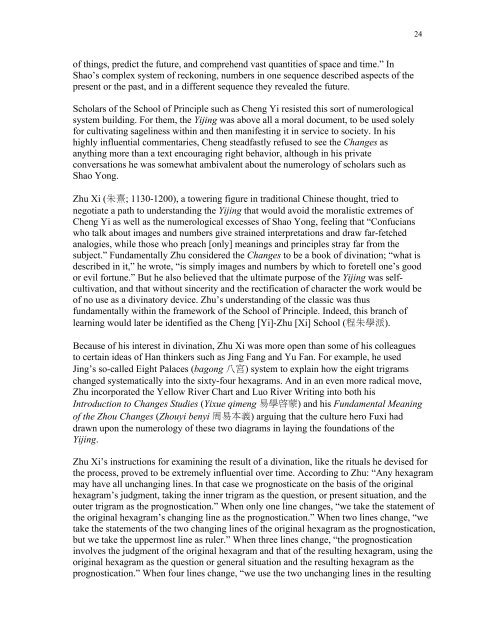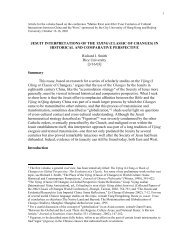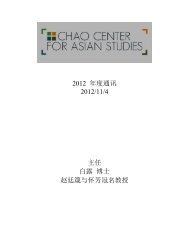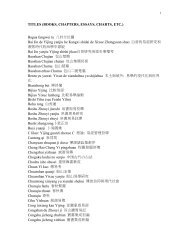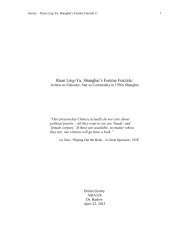Key Concepts of Fate and Prediction in the Yijing - Chao Center for ...
Key Concepts of Fate and Prediction in the Yijing - Chao Center for ...
Key Concepts of Fate and Prediction in the Yijing - Chao Center for ...
Create successful ePaper yourself
Turn your PDF publications into a flip-book with our unique Google optimized e-Paper software.
24<strong>of</strong> th<strong>in</strong>gs, predict <strong>the</strong> future, <strong>and</strong> comprehend vast quantities <strong>of</strong> space <strong>and</strong> time.” InShao’s complex system <strong>of</strong> reckon<strong>in</strong>g, numbers <strong>in</strong> one sequence described aspects <strong>of</strong> <strong>the</strong>present or <strong>the</strong> past, <strong>and</strong> <strong>in</strong> a different sequence <strong>the</strong>y revealed <strong>the</strong> future.Scholars <strong>of</strong> <strong>the</strong> School <strong>of</strong> Pr<strong>in</strong>ciple such as Cheng Yi resisted this sort <strong>of</strong> numerologicalsystem build<strong>in</strong>g. For <strong>the</strong>m, <strong>the</strong> Yij<strong>in</strong>g was above all a moral document, to be used solely<strong>for</strong> cultivat<strong>in</strong>g sagel<strong>in</strong>ess with<strong>in</strong> <strong>and</strong> <strong>the</strong>n manifest<strong>in</strong>g it <strong>in</strong> service to society. In hishighly <strong>in</strong>fluential commentaries, Cheng steadfastly refused to see <strong>the</strong> Changes asanyth<strong>in</strong>g more than a text encourag<strong>in</strong>g right behavior, although <strong>in</strong> his privateconversations he was somewhat ambivalent about <strong>the</strong> numerology <strong>of</strong> scholars such asShao Yong.Zhu Xi (; 1130-1200), a tower<strong>in</strong>g figure <strong>in</strong> traditional Ch<strong>in</strong>ese thought, tried tonegotiate a path to underst<strong>and</strong><strong>in</strong>g <strong>the</strong> Yij<strong>in</strong>g that would avoid <strong>the</strong> moralistic extremes <strong>of</strong>Cheng Yi as well as <strong>the</strong> numerological excesses <strong>of</strong> Shao Yong, feel<strong>in</strong>g that “Confucianswho talk about images <strong>and</strong> numbers give stra<strong>in</strong>ed <strong>in</strong>terpretations <strong>and</strong> draw far-fetchedanalogies, while those who preach [only] mean<strong>in</strong>gs <strong>and</strong> pr<strong>in</strong>ciples stray far from <strong>the</strong>subject.” Fundamentally Zhu considered <strong>the</strong> Changes to be a book <strong>of</strong> div<strong>in</strong>ation; “what isdescribed <strong>in</strong> it,” he wrote, “is simply images <strong>and</strong> numbers by which to <strong>for</strong>etell one’s goodor evil <strong>for</strong>tune.” But he also believed that <strong>the</strong> ultimate purpose <strong>of</strong> <strong>the</strong> Yij<strong>in</strong>g was selfcultivation,<strong>and</strong> that without s<strong>in</strong>cerity <strong>and</strong> <strong>the</strong> rectification <strong>of</strong> character <strong>the</strong> work would be<strong>of</strong> no use as a div<strong>in</strong>atory device. Zhu’s underst<strong>and</strong><strong>in</strong>g <strong>of</strong> <strong>the</strong> classic was thusfundamentally with<strong>in</strong> <strong>the</strong> framework <strong>of</strong> <strong>the</strong> School <strong>of</strong> Pr<strong>in</strong>ciple. Indeed, this branch <strong>of</strong>learn<strong>in</strong>g would later be identified as <strong>the</strong> Cheng [Yi]-Zhu [Xi] School ().Because <strong>of</strong> his <strong>in</strong>terest <strong>in</strong> div<strong>in</strong>ation, Zhu Xi was more open than some <strong>of</strong> his colleaguesto certa<strong>in</strong> ideas <strong>of</strong> Han th<strong>in</strong>kers such as J<strong>in</strong>g Fang <strong>and</strong> Yu Fan. For example, he usedJ<strong>in</strong>g’s so-called Eight Palaces (bagong ) system to expla<strong>in</strong> how <strong>the</strong> eight trigramschanged systematically <strong>in</strong>to <strong>the</strong> sixty-four hexagrams. And <strong>in</strong> an even more radical move,Zhu <strong>in</strong>corporated <strong>the</strong> Yellow River Chart <strong>and</strong> Luo River Writ<strong>in</strong>g <strong>in</strong>to both hisIntroduction to Changes Studies (Yixue qimeng 啓 ) <strong>and</strong> his Fundamental Mean<strong>in</strong>g<strong>of</strong> <strong>the</strong> Zhou Changes (Zhouyi benyi ) argu<strong>in</strong>g that <strong>the</strong> culture hero Fuxi haddrawn upon <strong>the</strong> numerology <strong>of</strong> <strong>the</strong>se two diagrams <strong>in</strong> lay<strong>in</strong>g <strong>the</strong> foundations <strong>of</strong> <strong>the</strong>Yij<strong>in</strong>g.Zhu Xi’s <strong>in</strong>structions <strong>for</strong> exam<strong>in</strong><strong>in</strong>g <strong>the</strong> result <strong>of</strong> a div<strong>in</strong>ation, like <strong>the</strong> rituals he devised <strong>for</strong><strong>the</strong> process, proved to be extremely <strong>in</strong>fluential over time. Accord<strong>in</strong>g to Zhu: “Any hexagrammay have all unchang<strong>in</strong>g l<strong>in</strong>es. In that case we prognosticate on <strong>the</strong> basis <strong>of</strong> <strong>the</strong> orig<strong>in</strong>alhexagram’s judgment, tak<strong>in</strong>g <strong>the</strong> <strong>in</strong>ner trigram as <strong>the</strong> question, or present situation, <strong>and</strong> <strong>the</strong>outer trigram as <strong>the</strong> prognostication.” When only one l<strong>in</strong>e changes, “we take <strong>the</strong> statement <strong>of</strong><strong>the</strong> orig<strong>in</strong>al hexagram’s chang<strong>in</strong>g l<strong>in</strong>e as <strong>the</strong> prognostication.” When two l<strong>in</strong>es change, “wetake <strong>the</strong> statements <strong>of</strong> <strong>the</strong> two chang<strong>in</strong>g l<strong>in</strong>es <strong>of</strong> <strong>the</strong> orig<strong>in</strong>al hexagram as <strong>the</strong> prognostication,but we take <strong>the</strong> uppermost l<strong>in</strong>e as ruler.” When three l<strong>in</strong>es change, “<strong>the</strong> prognostication<strong>in</strong>volves <strong>the</strong> judgment <strong>of</strong> <strong>the</strong> orig<strong>in</strong>al hexagram <strong>and</strong> that <strong>of</strong> <strong>the</strong> result<strong>in</strong>g hexagram, us<strong>in</strong>g <strong>the</strong>orig<strong>in</strong>al hexagram as <strong>the</strong> question or general situation <strong>and</strong> <strong>the</strong> result<strong>in</strong>g hexagram as <strong>the</strong>prognostication.” When four l<strong>in</strong>es change, “we use <strong>the</strong> two unchang<strong>in</strong>g l<strong>in</strong>es <strong>in</strong> <strong>the</strong> result<strong>in</strong>g


